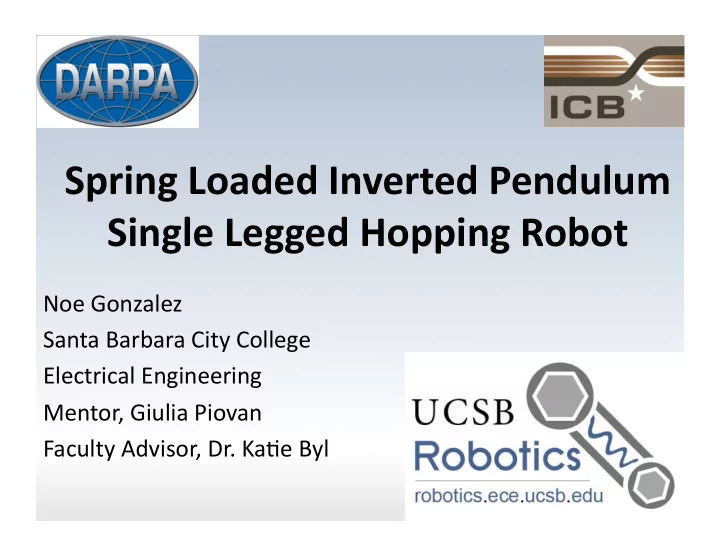

Spring Loaded Inverted Pendulum Single Legged Hopping Robot Noe Gonzalez Santa Barbara City College Electrical Engineering Mentor, Giulia Piovan Faculty Advisor, Dr. KaAe Byl
A New Generation of Robots A New Generation of Robots M3 Program(DARPA ) • Maximum Mobility & ManipulaAon • CreaAon & Enhancement • Jointed & Legged bots • Natural Environments Focus on Rough Terrain Unmanned (Image from hOp://www.bostondynamics.com/) Military OperaEons • TransportaAon of Supplies & Equipment • EvacuaAon of Injured personnel • ExploraAon of remote and hazardous areas • Search and rescue • Advanced ScouAng
Spring-Loaded Inverted Pendulum(SLIP) Model Goal: To simulate a real & successful trajectory on rough terrain of the model using Matlab . Apex State: Highest Point
Defining the SLIP Model EquaAons Fixed Variables m=1 kg L0= 1 m k= 106 N/m Vary (dx, y)
Height (m) IniAal CondiAons: Distance traveled (m) x = 0 y = 1.57 m dx = 6.57 m/s
For each set of points (dx, y), we know the degree span we can use Height (m) Forward velocity, dx (m/s)
LocaAng point on known grid • Locate random point between 4 known points for which we know the angle range for (.05 intervals) y • Choose the middle point of the range in order to have an angle that will allow a successful jump. dx P(dx,y) = (6.54, 1.57)
Angle span with respect to an iniAal height and velocity IniAal apex height y (m) Degree span P(dx,y) IniAal forward velocity dx (m/s)
Height = 1.57 (m) Velocity = 6.54 (m/s)
Angle span with respect to an iniAal height and velocity IniAal apex height y (m) Degree Span P(dx,y) = (7.99, 2.01) No SoluAon P(dx,y) IniAal forward velocity dx (m/s)
Gaussian normal distribuAon on sensor error IniAal apex height y (m) IniAal forward velocity dx (m/s) The farther the point is, the less consideraAon we take of that point since it’s unlikely to be real.
RelaAve to the Big Picture • Implement SLIP model to biped and quadruped robots to give ability to run or jump when needed.
Summary • Defined equaAons of moAon • Constructed a look up table that shows angle range for specific set of points • Model successful and unsuccessful jumps • Used a Gaussian normal distribuAon to distribute the error percentage that we may encounter • Video clips of the model
Thank You INSET : For the opportunity to be part of this great program: Dr. Nick Arnold, Jens Kuhn Giulia Piovan : For being a great mentor Dr. KaEe Byl : For allowing me to work on her amazing lab CrisEna Luna : For your conAnuous support, I love you MESA/SHPE : For coming out and supporAng Virginia Estrella : For all of your great and wise guidance
Future Work: Implement an actuator to leg in order to add energy to the trajectory so that it can overcome big obstacles.
Recommend
More recommend